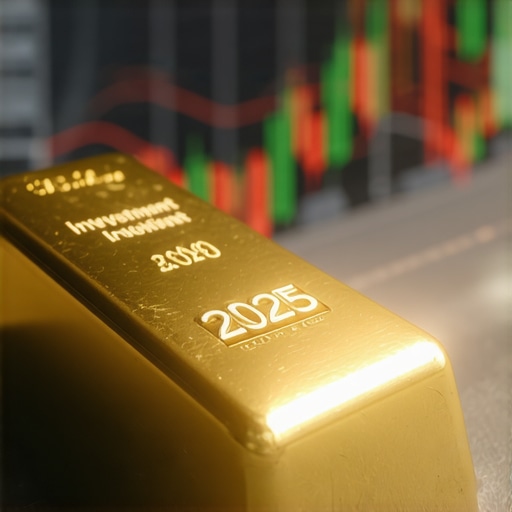Gold’s Strategic Role in Modern Portfolio Risk Management
In an era marked by unprecedented economic volatility and inflationary pressures, gold remains an indispensable asset for portfolio protection. Its intrinsic value and low correlation with traditional financial instruments make gold a superior hedge against systemic risks and currency depreciation. Investors seeking to safeguard wealth must move beyond simplistic allocations and embrace nuanced gold investment strategies tailored to contemporary market dynamics.
Decoding Gold’s Hedging Characteristics Amid Inflation and Market Turbulence
Gold’s historical performance during inflationary spikes and financial crises underscores its effectiveness as a hedging instrument. Unlike equities and bonds, gold often appreciates when fiat currencies weaken, preserving purchasing power. This inverse relationship derives from gold’s status as a tangible store of value and its limited supply, which is influenced by geopolitical and central bank activities. Understanding these complex supply-demand drivers is crucial for leveraging gold’s hedge potential effectively.
How Do Central Bank Gold Purchases Influence Portfolio Hedging Strategies?
Central banks significantly impact gold’s market dynamics through strategic acquisitions, which can signal macroeconomic trends and affect price volatility. Their accumulation of gold reserves often reflects attempts to diversify away from dollar dependency, thus reinforcing gold’s role as a safe haven. For sophisticated investors, monitoring these purchases provides actionable insights to optimize timing and allocation in gold holdings, enhancing portfolio resilience against systemic shocks. For a detailed analysis, explore how central bank gold purchases drive gold price movements in 2025.
Optimizing Gold Exposure: Balancing Physical Assets and Financial Instruments
Allocating to gold requires discerning between physical gold investments—such as bars and coins—and financial derivatives like ETFs, mutual funds, and mining stocks. Physical gold offers direct ownership and security benefits but entails storage and liquidity considerations. Conversely, gold ETFs and mutual funds provide ease of trading and diversification but expose investors to market risks and management fees. An informed blend can maximize hedging efficacy while managing cost and accessibility. For expert guidance, see our comprehensive overview on types of gold investments: choosing between bars, coins, and ETFs.
Advanced Portfolio Integration: Tactical Gold Allocation and Risk Adjustments
Incorporating gold as a hedge involves tactical allocation adjustments based on market signals and risk tolerance. Dynamic rebalancing aligned with inflation forecasts, currency trends, and geopolitical risks ensures gold’s protective function is maximized without eroding portfolio growth potential. Furthermore, integrating gold mining equities can add leverage to gold price movements but requires careful risk assessment due to operational and regulatory factors. Investors should consider these variables to refine their hedging strategy.
Expert CTA: Elevate Your Gold Investment Knowledge and Strategy
To deepen your understanding and expertly navigate gold investments, explore our specialized articles on best gold investment strategies to hedge inflation and economic risks and share your professional insights with our community of seasoned investors.
According to the World Gold Council, gold’s unique properties make it a critical component in hedging portfolios against inflation and currency risks, highlighting the importance of strategic allocation in uncertain economic climates (World Gold Council: Gold as a Portfolio Diversifier).
Leveraging Gold Mining Stocks for Amplified Portfolio Diversification
While physical gold and ETFs offer stability and liquidity, gold mining stocks introduce a compelling dimension of leverage to gold price movements. These equities benefit not only from rising gold prices but also from operational efficiencies and exploration successes. However, investors must navigate sector-specific risks including geopolitical instability, environmental regulations, and commodity price volatility. A thorough due diligence process, combined with tactical portfolio weight adjustments, can harness the upside potential of gold miners while mitigating inherent risks. Interested readers can deepen their knowledge through our detailed step-by-step guide to investing in gold mining stocks today.
Dynamic Hedging: Adapting Gold Allocations Amid Shifting Economic Indicators
Static allocation to gold may fail to capture evolving market risks and inflationary trends. Employing dynamic hedging strategies—where gold exposure is increased during heightened inflation expectations or geopolitical tensions and reduced during stable periods—can optimize portfolio performance. Utilizing quantitative models that integrate real-time economic data, such as inflation indices, currency fluctuations, and central bank policies, empowers investors to recalibrate gold holdings proactively. This nuanced approach minimizes opportunity costs while preserving gold’s protective benefits.
Can Advanced Analytics Enhance Timing and Sizing of Gold Investments?
Emerging data analytics and machine learning models are transforming how investors approach gold allocation decisions. By analyzing complex datasets encompassing macroeconomic indicators, central bank activities, and market sentiment, these tools offer predictive insights that outperform traditional heuristics. The challenge lies in integrating qualitative geopolitical intelligence with quantitative signals to formulate robust, adaptive strategies. As such, incorporating these advanced analytical frameworks could significantly improve timing and sizing of gold investments, thereby enhancing portfolio resilience and growth potential.
For a comprehensive analysis on how gold acts as a portfolio diversifier and the latest analytical tools used, the World Gold Council provides authoritative research and market insights.
Mitigating Risks: Best Practices for Secure Physical Gold Ownership
Physical gold’s intrinsic value is unmatched, but ownership entails unique risks such as theft, counterfeit products, and liquidity constraints. Investors should prioritize purchasing from reputable dealers, employing secure storage solutions like insured vaults, and maintaining thorough documentation to verify authenticity and provenance. Additionally, understanding tax implications and insurance options is critical for safeguarding physical gold investments. Our expert recommendations on physical gold investment top tips for secure ownership offer essential guidance for new and seasoned investors alike.
Balancing Costs and Benefits: Choosing Between Gold ETFs and Mutual Funds
Gold ETFs and mutual funds provide accessible avenues for gold exposure, each with distinct cost structures and investment characteristics. ETFs typically offer lower expense ratios and intraday liquidity, making them suitable for active traders and tactical adjustments. Mutual funds, while potentially incurring higher fees, may deliver professional management and diversified exposure including mining stocks and bullion-backed assets. Evaluating fund objectives, fee transparency, and historical performance is vital for aligning choices with individual investment goals and risk tolerance. Explore our insights on the top gold ETFs and mutual funds for 2025 growth strategy to make informed selections.
Expert CTA: Share Your Thoughts and Expand Your Gold Investment Acumen
We invite seasoned investors and market strategists to share their insights on dynamic gold allocation tactics and advanced analytics in the comments below. To further enhance your portfolio strategies, consider exploring our comprehensive guides on best gold investment strategies to hedge inflation and economic risks and how central bank gold purchases drive gold price movements in 2025.
Integrating Blockchain Transparency to Revolutionize Gold Ownership and Trading
In the evolving landscape of gold investment, blockchain technology emerges as a groundbreaking tool that enhances transparency, provenance verification, and liquidity. By embedding gold transactions on immutable ledgers, investors gain unparalleled assurance regarding authenticity and chain of custody, addressing long-standing concerns about counterfeit and fraud in physical gold markets. Moreover, tokenization of gold assets facilitates fractional ownership and democratizes access, enabling smaller investors to participate in gold portfolios with reduced entry barriers and enhanced liquidity.
Beyond individual investors, blockchain platforms empower institutional players to conduct real-time audits and streamline compliance with regulatory frameworks, mitigating operational risks. These innovations herald a new paradigm where gold’s traditional role as a safe haven is complemented by cutting-edge digital infrastructure, amplifying its appeal in diversified portfolios.
How Does Blockchain-Enabled Tokenization Affect Gold Liquidity and Market Efficiency?
Tokenization converts physical gold into digital tokens that represent fractional ownership, tradable on blockchain networks 24/7. This disruption significantly enhances liquidity by enabling instantaneous settlement and reducing reliance on intermediaries. Market efficiency improves as price discovery becomes more transparent and accessible, fostering tighter spreads and reduced volatility. However, investors must navigate regulatory uncertainty and ensure custodial arrangements maintain rigorous security standards.
Leading enterprises and consortia, such as the London Bullion Market Association (LBMA), are actively exploring blockchain standards to bolster market integrity and investor confidence.
Embedding ESG Criteria into Gold Investments: Navigating Ethical and Regulatory Frontiers
The surge in Environmental, Social, and Governance (ESG) investing compels a re-examination of gold sourcing and mining practices. Sophisticated investors demand transparency on carbon footprints, labor conditions, and community impacts linked to gold production. This shift not only influences portfolio selection but also drives mining companies toward sustainable operations, enhanced reporting, and stakeholder engagement.
Integrating ESG factors requires robust due diligence frameworks that assess supplier certifications, traceability mechanisms, and compliance with international standards such as the Responsible Gold Mining Principles developed by the LBMA. Investors leveraging ESG criteria can reduce reputational risks and align portfolios with broader sustainability goals, potentially accessing premium valuations for responsible gold assets.
What Are the Challenges and Opportunities in ESG-Compliant Gold Mining Investments?
Challenges include inconsistent ESG reporting, regional regulatory disparities, and the complexity of verifying supplier claims. Conversely, opportunities arise from growing consumer and regulatory demand for ethically sourced gold, incentivizing innovation in mining technologies and community partnerships. Funds focused on ESG-compliant gold equities often exhibit resilience amid market fluctuations by appealing to conscientious investors.
For comprehensive insights, consult the World Gold Council’s Responsible Gold Mining Principles, which outline best practices and investor expectations.
Advanced Quantitative Models: Forecasting Gold Price Dynamics with Machine Learning and Alternative Data
Cutting-edge portfolio managers increasingly adopt machine learning algorithms and alternative data sources—such as satellite imagery of mining operations, social media sentiment, and macroeconomic indicators—to forecast gold price movements. These models transcend traditional econometric approaches by capturing nonlinear relationships and complex interactions, enhancing predictive accuracy and timing strategies.
However, integrating such models demands rigorous validation to avoid overfitting and ensure robustness across market regimes. Additionally, interpretability remains a critical concern, as opaque models may hinder trust and decision-making. Hybrid approaches that combine domain expertise with algorithmic insights are proving most effective in harnessing these technologies.
Expert CTA: Dive Deeper into the Future of Gold Investing
Embrace the convergence of technology, sustainability, and advanced analytics to elevate your gold investment strategies. Explore our upcoming series on future-proof gold investment methodologies incorporating blockchain, ESG, and AI and join a community of experts pioneering the next generation of portfolio innovation.
Quantum Computing and AI: The Frontier of Gold Market Forecasting
The integration of quantum computing with artificial intelligence (AI) heralds transformative potential for gold market analytics. Quantum algorithms can process vast, multidimensional datasets and simulate complex market dynamics at unprecedented speeds, enabling real-time scenario analyses that classical systems cannot achieve. In conjunction with AI’s pattern recognition and adaptive learning capabilities, this synergy offers a paradigm shift in anticipating gold price volatility and optimizing portfolio hedging.
Such advancements empower institutional investors to transcend conventional predictive limitations, incorporating quantum-enhanced risk assessments and portfolio optimization frameworks that adapt dynamically to unfolding economic variables.
How Will Quantum-Enhanced AI Models Reshape Gold Portfolio Risk Management?
Quantum-enhanced AI models leverage superposition and entanglement to evaluate multiple market hypotheses simultaneously, drastically shrinking computation times for scenario testing. This capability facilitates the rapid adjustment of gold allocations in response to non-linear market shocks, inflation surprises, and geopolitical upheavals. Consequently, portfolio managers can implement hyper-responsive hedging strategies that balance risk mitigation and capital growth with heightened precision.
These models also incorporate alternative data streams—including geospatial analytics of mining operations and sentiment analyses from global news feeds—offering a holistic, data-driven approach to gold investment decisions. The challenge remains in translating quantum outputs into actionable insights within existing risk management infrastructures.
Enhancing Gold Supply Chain Transparency Through AI-Driven Predictive Analytics
Beyond price forecasting, AI-driven predictive analytics are revolutionizing the gold supply chain by anticipating disruptions, optimizing logistics, and verifying provenance. Machine learning algorithms analyze multi-source data ranging from satellite imagery to trade flows, forecasting potential bottlenecks caused by regulatory changes, environmental events, or labor disputes.
This granular visibility enables investors and miners alike to preemptively manage risks, ensuring the stability of physical gold availability and supporting ESG compliance efforts. By coupling these insights with blockchain-based provenance verification, the gold market can achieve unprecedented levels of trust and operational resilience.
Refining ESG Integration: Quantitative Metrics and AI-Enabled Monitoring
Advances in AI facilitate the quantification and continuous monitoring of ESG factors within gold mining operations. Natural language processing analyzes sustainability reports, social media, and regulatory filings to detect compliance deviations or reputational risks in near real-time. Meanwhile, AI models quantify environmental impacts such as carbon emissions and water usage, enabling investors to assess and compare ESG performance with greater objectivity.
This data-driven approach supports the construction of ESG-optimized gold portfolios that meet stringent ethical standards without compromising financial returns, aligning with evolving investor mandates and regulatory frameworks.
For a comprehensive review of AI’s role in sustainable gold investing, visit the World Gold Council’s research on AI and sustainability in gold.
Expert CTA: Explore Cutting-Edge Technologies Shaping Gold Investment
Stay at the vanguard of gold investment innovation by engaging with our expert analyses on quantum computing, AI, and sustainable finance. Join our forum of thought leaders and elevate your portfolio strategies by subscribing to our upcoming webinar series on quantum and AI-powered gold investment methodologies.

Expert Insights & Advanced Considerations
Blockchain Tokenization: Transforming Gold Liquidity and Accessibility
Leveraging blockchain technology to tokenize physical gold fundamentally reshapes market liquidity by enabling fractional ownership and 24/7 trading. This innovation not only democratizes access for smaller investors but also enhances transparency and provenance verification, mitigating traditional risks associated with counterfeit gold. Investors should consider integrating tokenized gold assets alongside physical holdings to optimize portfolio flexibility.
Quantum Computing and AI: Next-Generation Forecasting Tools
The fusion of quantum computing with AI algorithms offers unprecedented capabilities in modeling gold price dynamics. These technologies enable rapid scenario testing and adaptive risk management, accommodating complex economic variables and geopolitical uncertainties that influence gold markets. Early adoption of quantum-enhanced AI models can provide portfolio managers with a competitive edge in dynamic hedging and allocation decisions.
ESG Integration: Balancing Ethical Standards with Financial Performance
Incorporating Environmental, Social, and Governance (ESG) criteria into gold investments is no longer optional but a strategic imperative. Advanced due diligence frameworks and AI-driven monitoring tools help investors evaluate mining companies’ sustainability practices, reducing reputational risks while potentially unlocking premium valuations. Aligning gold holdings with ESG principles supports long-term portfolio resilience amid evolving regulatory landscapes.
Dynamic Hedging: Responsive Gold Allocation Strategies
Static allocations fail to capture the fluidity of inflationary pressures and geopolitical risks. Employing dynamic hedging—adjusting gold exposure in real time based on inflation forecasts, currency trends, and central bank activities—maximizes protective benefits without sacrificing growth potential. Integrating alternative data analytics and market sentiment indicators enhances timing precision and portfolio performance.
Gold Mining Stocks: Leveraged Exposure with Sector-Specific Risks
Gold mining equities offer amplified exposure to gold price movements, driven by operational efficiencies and exploration outcomes. However, investors must diligently assess geopolitical risks, regulatory environments, and commodity price volatility. A balanced approach combining physical gold, ETFs, and selective mining stocks can optimize diversification and return potentials.
Curated Expert Resources
- World Gold Council Research Hub: Offers authoritative analyses on gold as a portfolio diversifier, ESG standards, and emerging technologies impacting gold markets. Essential for staying informed on global trends and regulatory developments (World Gold Council).
- BuyingGoldNow’s Guide to Gold Mining Stocks: A detailed step-by-step resource for evaluating and investing in gold mining equities, highlighting risk factors and growth opportunities (Step-by-step guide to investing in gold mining stocks today).
- Gold ETFs and Mutual Funds Overview: Comprehensive insights into selecting the right funds for diversification and cost efficiency in 2025 portfolios (Top gold ETFs and mutual funds for 2025 growth strategy).
- Physical Gold Ownership Best Practices: Expert recommendations on secure purchasing, storage, and verification techniques critical for safeguarding physical gold investments (Physical gold investment top tips for secure ownership).
- Advanced Analytics in Gold Investing: Explores the integration of AI and machine learning in forecasting gold price trends and optimizing allocations (Guide to gold price forecast: what investors must know now).
Final Expert Perspective
Gold’s enduring value as a portfolio hedge is being profoundly enhanced by technological innovations and evolving investor priorities. From blockchain-enabled tokenization improving liquidity and transparency to quantum-AI models revolutionizing predictive accuracy, the gold investment landscape demands sophisticated, adaptive strategies. Integrating ESG principles ensures that portfolios remain resilient and ethically aligned, while dynamic allocation techniques optimize risk mitigation amid volatile economic indicators. By embracing these advanced approaches and leveraging curated expert resources, investors can confidently navigate the complexities of gold investing in 2025 and beyond. Engage with our detailed analyses and join the discourse to refine your gold investment strategy and safeguard capital with informed expertise.










This article provides a remarkably comprehensive overview of how gold can be integrated into modern portfolio risk management, especially amidst today’s economic turbulence. I’ve personally found that diversifying with physical gold, particularly through secure vault storage, has provided a tangible sense of security, especially when geopolitical tensions escalate. I’m intrigued by the potential of blockchain tokenization, as it seems to democratize access and enhance liquidity, but I wonder about the current regulatory landscape—how do you see it evolving to support widespread adoption? Additionally, balancing physical gold with ETFs and mining stocks appears to offer a strategic way to leverage gold’s benefits while managing operational risks. Has anyone experimented with dynamic rebalancing strategies based on real-time market signals, and what tools or models have proved most effective? I believe that integrating advanced analytics and ESG considerations could further refine these approaches, making gold a more resilient component in diverse portfolios.